Thrips in greenhouse crops - biology, damage and management
Learn about the life history, damage caused by, and management of thrips in greenhouse crops.
Introduction
Thrips are a major pest of greenhouse crops in Ontario. A number of thrips species are commonly found including western flower thrips (Frankliniella occidentalis), eastern flower thrips (Frankliniella tritici), onion thrips (Thrips tabaci), and Echinothrips. However, western flower thrips is the predominant species and the most difficult to control.
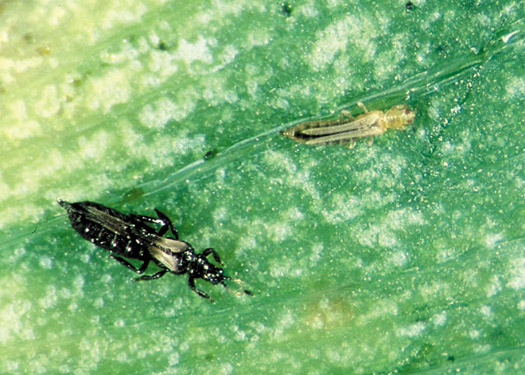
Figure 1. Comparison between adult western flower thrips (right) and adult Echinothrips (left).
Adult western flower thrips are approximately 1-2 mm in length and generally yellowish-brown in colour. Identification to the species level is difficult (especially among western flower thrips, eastern flower thrips and onion thrips) because they are so small and their colour varies. Adults are the only stage that can be identified to species. Identification should be done by specialists.
Life history
The life cycle consists of five stages: egg, larval, prepupal, pupal and adult. Female adult western flower thrips live up to 30 days and lay 2-10 eggs per day. At 20°C, development from egg to adult takes approximately 19 days. At 25°C, it takes 13 days. The eggs are inserted into soft plant tissues, including flowers, leaves, stems and fruit. In sweet pepper, egg hatch gives the leaves a speckled appearance, with the degree of speckling corresponding to the number of hatched eggs. The larval stage (see Figure 2) consists of 2 instars that feed and develop on the leaves, flowers and fruit. The prepupal and pupal stages often complete their development on the ground or growing medium, but pupation can also take place on the plant. The pupa (see Figure 3) is a non-feeding stage during which the wings and other adult structures form.

Figure 2. First and second larval instars plus adult of western flower thrips.
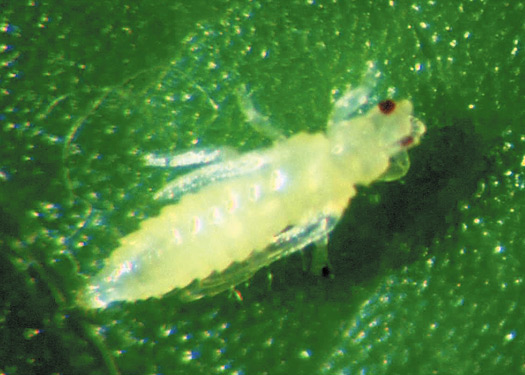
Figure 3. Pupal stage of western flower thrips.
The adults are weak fliers, usually taking short flights from leaf to leaf or plant to plant. Nevertheless, they disperse rapidly throughout the greenhouse. Adult thrips can be transported on wind currents and will enter the greenhouse through vents and doorways. At all stages they may be dispersed on workers' clothing and on infested plants, growing media or farm implements.
Damage
The adult and larval stages feed by piercing the plant surface with their mouthparts and sucking the contents of plant cells. This causes white or brown spots on the leaves where the plant cells have been destroyed. These spots are also speckled with dark fecal droppings from the thrips.
Vegetable Crops
In cucumber (see Figure 4) and tomato, thrips damage is noticed first on the lower leaves. In sweet pepper (see Figure 5), it is evident in the upper youngest leaves. Heavy infestations reduce the ability of the plants to photosynthesize, reducing the yield. On vegetable flowers, thrips feeding creates silvery white streaks on the petals. Fruit damage varies according to the crop. For instance, in cucumber fruit, feeding creates severe distortion and curling as well as white streaks (see Figure 6). Feeding on sweet pepper (see Figure 7) causes silvery or bronze streaks or spots on the fruit. Thrips also feed on the calyx, causing it to turn up and expose the fruit to bacterial infections. On tomato, thrips may lay eggs in the fruit, creating ghost-spotting (see Figure 8). Ghost-spotting can also occur with sweet pepper and cucumber.
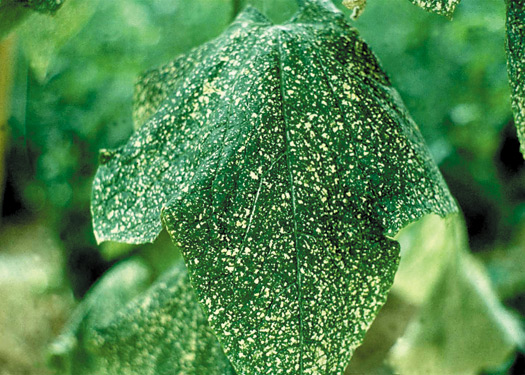
Figure 4. Thrips feeding damage on cucumber leaves.
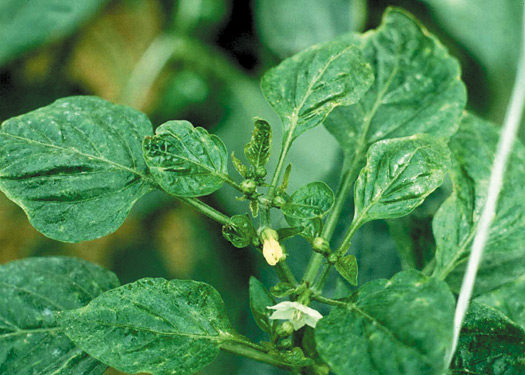
Figure 5. Thrips feeding damage on pepper leaves.
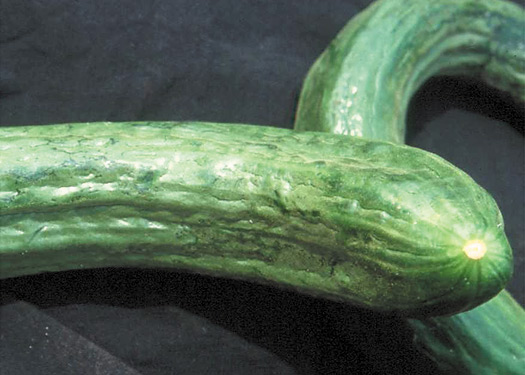
Figure 6. Thrips feeding damage on cucumber fruit.
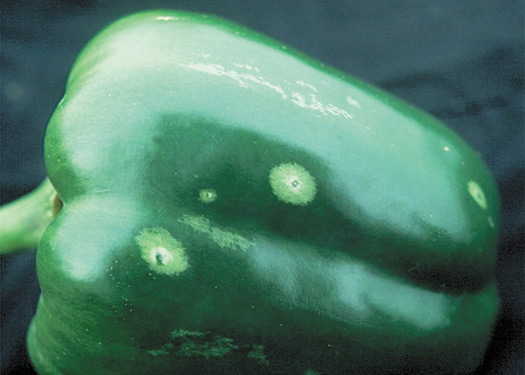
Figure 7. Egg-laying scars and feeding damage on sweet pepper.
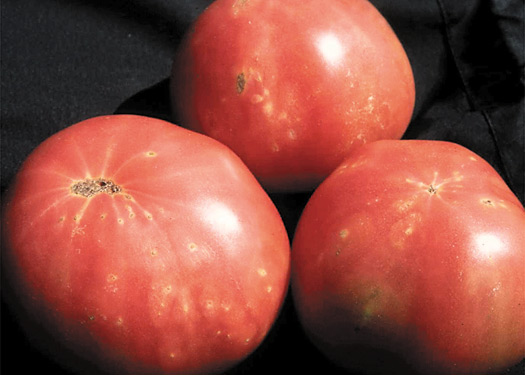
Figure 8. Thrips egg-laying scars on tomato
Ornamental Crops
Western flower thrips has a host range of hundreds of plant species, including many major commercial floriculture crops. Damage includes feeding scars and leaf distortion (see Figures 9 and 10). Thrips are particularly attracted to flowers, where they cause damage such as streaking and scarring of petals, distortion of flowers and flower buds and incomplete petal expansion (see Figures 11 and 12).
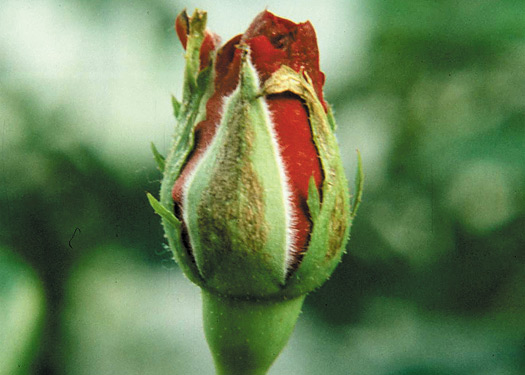
Figure 9. Thrips feeding damage on roses. (Photo credit: Colleen Teerling, Agriculture and Agri-Food Canada)
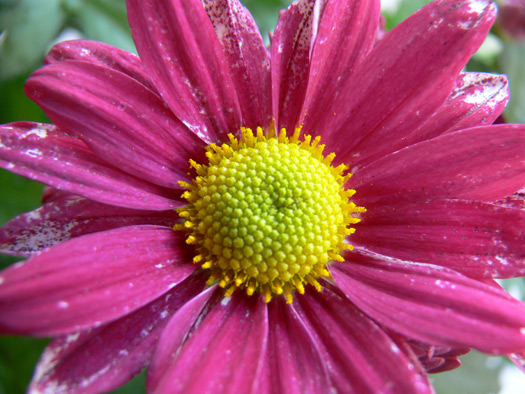
Figure 10. Thrips feeding damage on chrysanthemum leaves.
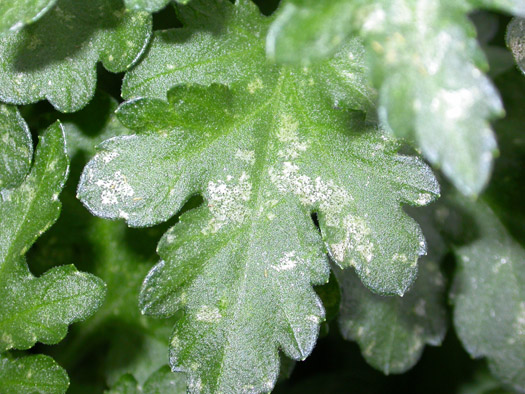
Figure 11. Thrips feeding damage on chrysanthemum.
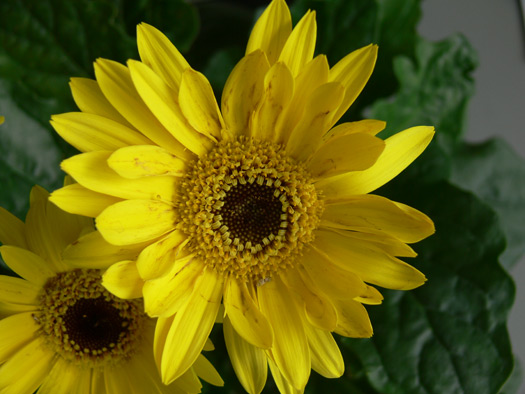
Figure 12. Thrips feeding damage on gerbera.
Virus Transmission
Western flower thrips is the most important vector of a group of viruses called tospoviruses. Tomato spotted wilt virus (TSWV) and impatiens necrotic spot virus (INSV) are the most common tospoviruses in greenhouse crops. In Ontario, TSWV is generally found in vegetable crops and some ornamental crops such as chrysanthemum, while INSV is more common in ornamental crops. In vegetables, symptoms of this disease vary according to the host, cultivar and stage of plant development, but it can severely reduce or even stop plant growth. Other general symptoms include stunting, bronzing and curling of the leaves, and distortion of affected plant areas. In addition, infected fruit are misshapen and ripen unevenly, often with a necrotic ring pattern (see Figures 13 and 14).
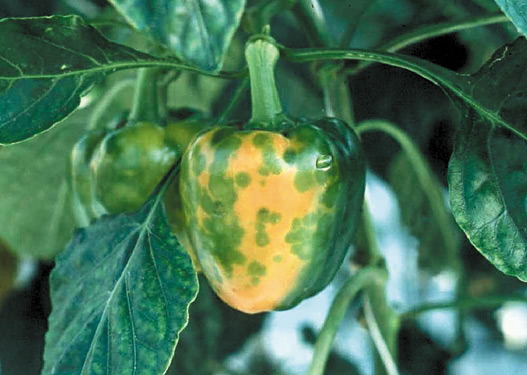
Figure 13. TSWV symptoms on pepper fruit.
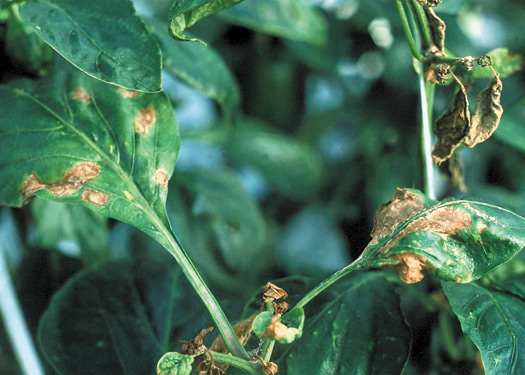
Figure 14. TSWV symptoms on pepper leaves.
In ornamental crops, many different species serve as hosts for INSV. Symptoms and susceptibility vary widely (see Figures 15-20) but include:
- ring spots and line patterns on leaves
- necrotic lesions
- black streaking on veins and stems
- stunting
- death of growing points and crown
- plant death in some crops (e.g., gloxinia)
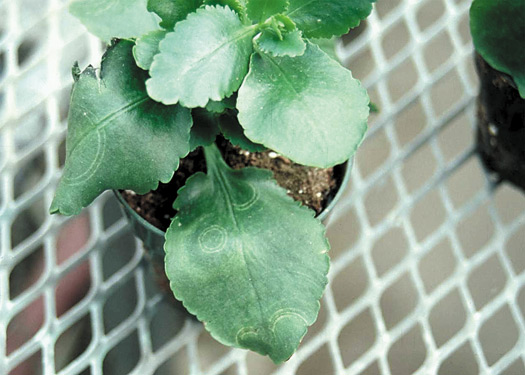
Figure 15. INSV symptoms on kalanchoe: concentric ring patterns.
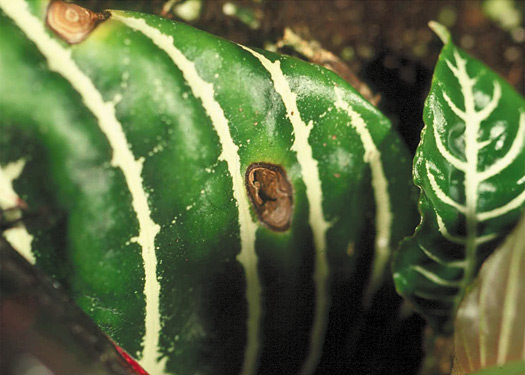
Figure 16. INSV symptoms on Aphelandra: necrotic leaf lesions.
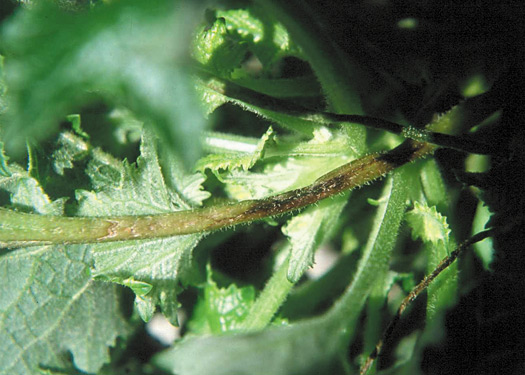
Figure 17. INSV symptoms on cineraria: stem lesions.
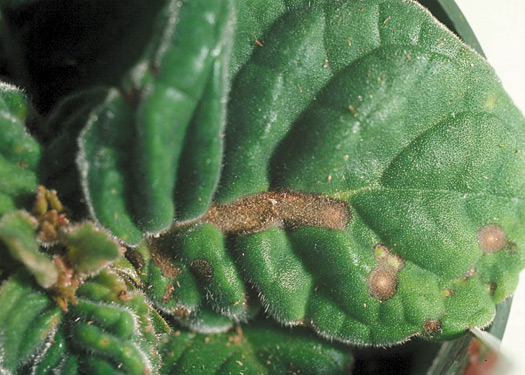
Figure 18. INSV symptoms on gloxinia: ring spots and leaf lesions.
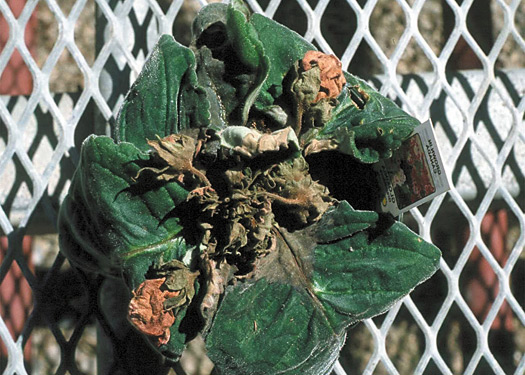
Figure 19. INSV symptoms on gloxinia: extreme necrosis leading to death.
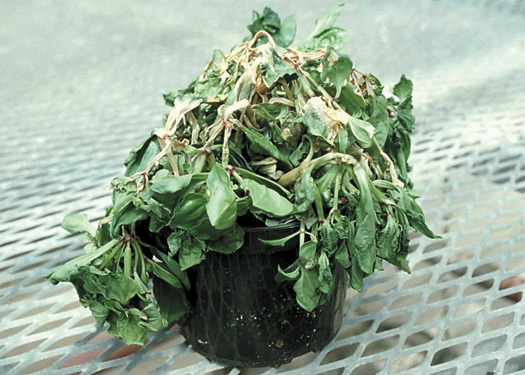
Figure 20. INSV symptoms on Exacum: complete plant collapse.
Management
Monitoring
Monitoring the population levels of western flower thrips is critical for successful pest management. In vegetable crops, monitoring should begin during propagation and continue after transplanting. In floriculture crops, thrips can be present at damaging levels year-round, although populations are usually smaller during winter. Commercially available blue or yellow sticky traps can be used to monitor the population densities of adult thrips (see Figure 21). Blue traps are more attractive to western flower thrips, although yellow traps are more attractive to other pests such as whiteflies and aphids. Your choice depends on how many pests you need to monitor, the susceptibility of the crop to thrips and/or tospoviruses and your need to detect thrips populations at low levels.
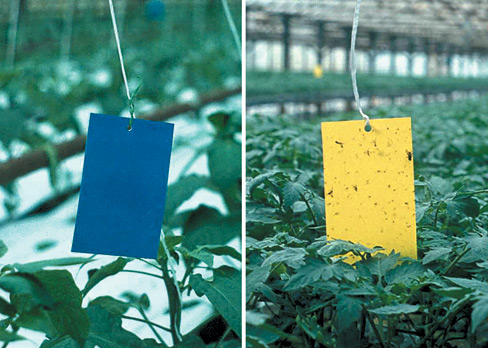
Figure 21. Sticky cards: blue (left) and yellow (right)
When setting up a monitoring program, use 1 trap per 100-200 m2. The exact number will depend on the layout of the greenhouse. A large open range will require a lower total density of cards than a greenhouse made up of a several smaller areas. Place the sticky cards in a grid pattern throughout the greenhouse. Check the traps weekly and record the average number of thrips per trap. Be aware that this is not an absolute measure of the population; rather, it measures increases and decreases in thrips numbers throughout the year. As you become more aware of how the numbers on sticky cards relate to the population in the crop, you can use the monitoring data to help you make pest management decisions. In greenhouse ornamentals, visually inspecting simple flowers, such as impatiens, can provide good estimates of thrips numbers in the crop. However, in more complex flowers, visual counts can be less reliable. In sweet pepper and cucumber crops, precision-level sampling programs have been developed for monitoring adult western flower thrips in the flowers. These sampling programs vary the number of samples taken according to the population level of the pest and accurately predict the pest density to set precision levels. Contact the OMAF Greenhouse Pest Management Specialist or your IPM Consultant for more detailed information before implementing your monitoring program.
Cultural control
Sanitation is the first and most important step in implementing an effective pest management program. Effective sanitation will reduce or even eliminate thrips as a pest problem. For example, in cut roses, removing all flower buds (including non-marketable flowers) can significantly reduce thrips populations in that crop. Cultural control measures also include maintaining a healthy crop and an optimal greenhouse environment (such as 80% relative humidity), creating less favourable conditions for a rapid increase in the density of thrips populations.
Physical control
An influx of outside pests, including thrips, can overwhelm your greenhouse IPM program, making it difficult to plan ahead. To prevent this, use screens to restrict the movement of insects into the greenhouse. For more information on screening, see the OMAF Factsheet Screening of Greenhouses for Insect Exclusion.
Biological control
Because thrips have developed resistance to most registered pesticides, biological control is now the primary strategy for controlling thrips in greenhouse crop production. Biological control agents include predatory mites such as:
- Neoseiulus (= Amblyseius) cucumeris
- Amblyseius swirskii
- Iphesius (= Amblyseius) degenerans
- Stratiolaelaps scimitus (= Hypoaspis miles)
- Gaeolaelaps gillespiei
- Gaeolaelaps aculeifer (= Hypoaspis aculeifer)
- minute pirate bugs (Orius insidiosus)
- nematodes (Steinernema feltiae)
- the fungal insect pathogen Beauveria bassiana
N. cucumeris (see Figure 22) and A. swirskii are the most extensively used predatory mites and look very similar. These mites control western flower thrips on the foliage by feeding on the first instar larvae. A. swirskii can also feed to a lesser extent on second instar thrips. As such, it takes a number of weeks for their impact to be seen in the greenhouse, and it is unlikely that they will completely eliminate thrips populations. The life cycle for N. cucumeris is completed in approximately 10 days at 20°C and 6 days at 25°C. A. swirskii has a higher optimal temperature for development than A. cucumeris and performs better in summer conditions. Its development time is similar to that of A. cucumeris but depends on the number and type of prey available.
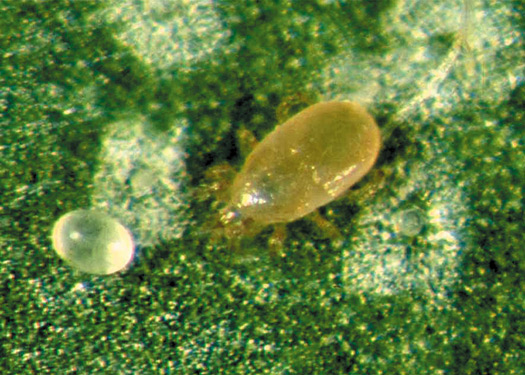
Figure 22. Adult and egg of Neoseiulus cucumeris.
Predatory mites should be introduced at the beginning of the crop or as soon as thrips are detected. Sanitation at the beginning and end of a cropping season is extremely important and will delay any thrips infestation until the biological control agents can be effective. Regular introductions of either N. cucumeris or A. swirskii are necessary, either by dispersing bran mixed with mites on plants or growing medium or by hanging a slow-release rearing sachet on plants (see Figure 23). The sachet system provides a continuous release of mites to the plant and should be replaced monthly. In ornamental production, many growers are now using new slow-release mini-sachets, which reduce the cost substantially and can be used on individual containers (e.g., hanging baskets or even 15-cm pots). Applying a supplemental food source such as apple pollen to chrysanthemum may help A. swirskii to get established when thrips levels are low. The number of introductions depends on the crop and level of thrips infestation (contact the OMAF Greenhouse Pest Management Specialist or your IPM Consultant). Control of the thrips should be achieved in 5-9 weeks. When using N. cucumeris or A. swirskii, it is important to maintain at least 70% relative humidity in the greenhouse and avoid using any persistent pesticides for several months before introducing the mites.
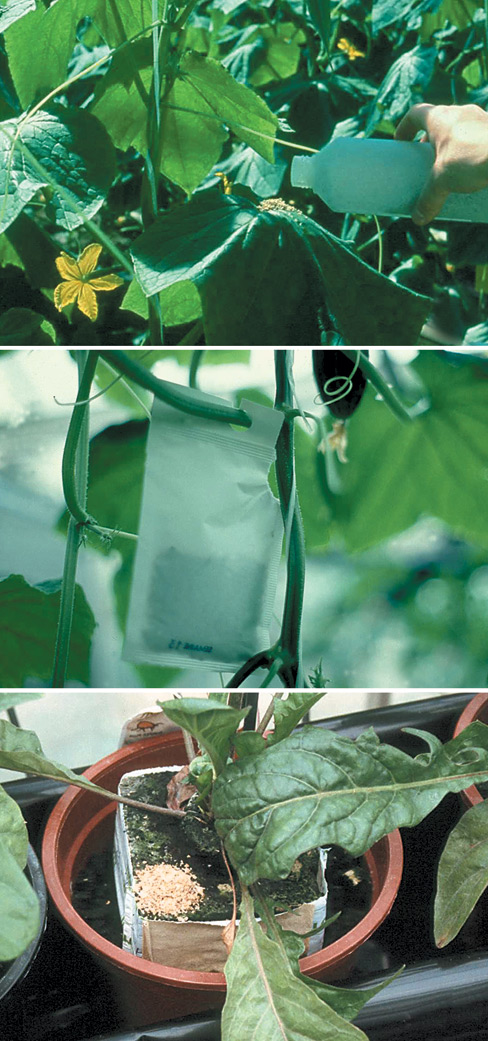
Figure 23. Methods for introducing predatory mites: directly on the plants (top), using a bag rearing system (middle) and piling bran on rockwool cubes or other growing medium (bottom).
Orius is effective in controlling thrips (see Figure 24). Unlike N. cucumeris and A. swirskii, Orius will feed on all stages of thrips. It is often found in the flowers, where it feeds on pollen as an alternative food source. Because pollen is not often present in ornamental crops, Orius is not as effective in flower crops as it is in vegetables. However, recent research has shown ornamental peppers can be used as a banker plant for Orius in other ornamental crops, allowing a population to establish, develop and disperse within the greenhouse. Some ornamental and vegetable growers are using this strategy to take advantage of the control potential offered by Orius. Development time for Orius from egg to adult is 31 days at 20°C and 19 days at 25°C. Orius enters reproductive diapause when there are less than 12 hr of light per day. Thus, Orius is only effective as a biological control agent from March to September.
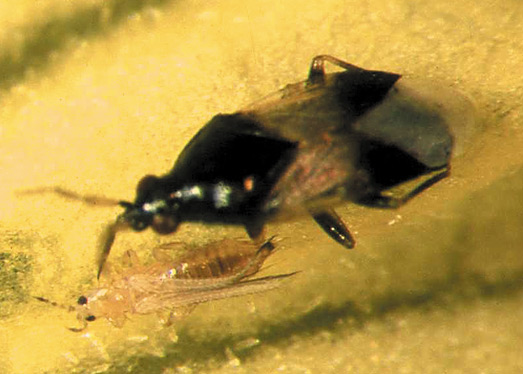
Figure 24. Adult Orius preying on western flower thrips.
Orius is best released when the pest level is low. One or two releases are usually enough to provide thrips control in approximately 3-5 weeks, depending on the level of thrips and the type of host crop. For greenhouse vegetable crops, Orius is most successfully used on peppers and cucumber. Introduce adults in several locations where they can naturally disperse by flying throughout the greenhouse. Flower sampling is the best method to monitor the presence of Orius.
Iphesius degenerans (see Figure 25) differs from N. cucumeris and A. swirskii in its appearance and its ability to tolerate less humid conditions. It is dark and very agile. Because it reproduces very well on pollen, it performs best in crops with a pollen source (e.g., greenhouse peppers) but is unlikely to be the best option for floricultural crops.
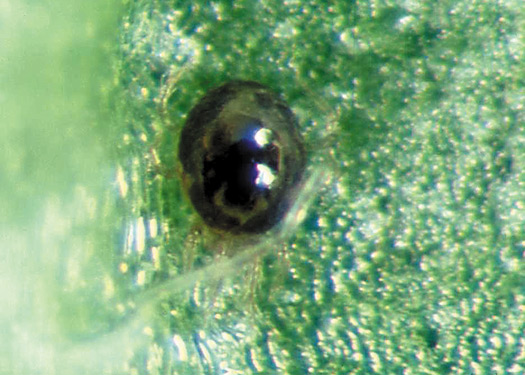
Figure 25. The predatory mite Iphesius degenerans.
Stratiolaelaps scimitus and Gaeolaelaps gillespiei (see Figure 26) are soil-dwelling predatory mites that feed on a variety of soil organisms, including thrips pupae. Apply either of these to the growing medium (e.g., rockwool, peat mixes) once only, at the beginning of the crop. Although it is difficult to determine the exact impact of these predators on a thrips population, research has estimated they can kill up to 30% of pupae. Because they are unlikely to provide enough control on their own, they are better used in combination with other predators.
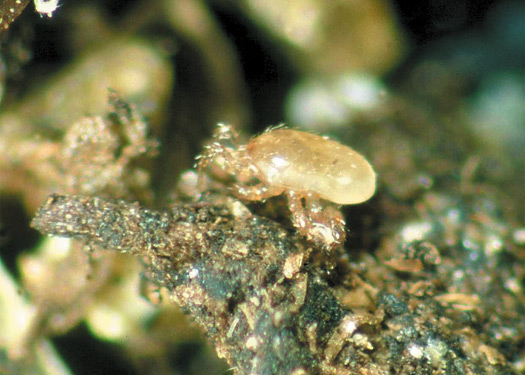
Figure 26. The predatory mite Stratiolaelaps scimitus.
Nematodes are frequently used by ornamental growers in Ontario. Research in Ontario and Europe has shown that they effectively control thrips pupae when applied to the growing medium on a weekly basis. To reduce costs, this is best done by overhead application in propagation, when the plants are pot tight.
Beauveria bassiana is a fungal pathogen of thrips. It is usually mixed in water and applied as a spray. Like many fungi, it is more effective under high humidity. Therefore, to treat ornamentals, it is most often applied in propagation. In vegetables, it can be either sprayed onto the crop or distributed via bumble bees that are supplied with hives specially equipped with dispensing trays. These trays contain Beauveria bassiana spores that are diluted with a powdered carrier. The bees must walk through the trays to leave the hives. In the process, some of the spore mixture sticks to their bodies. The spores become distributed in the crop when the bees fly in search of nectar and pollen and when they pollinate the crops. When thrips come into contact with spores on the crop surface, they become infected and die.
Chemical control
Chemical control of western flower thrips can be difficult. They are resistant to most pesticides and feed deep within the flower head or on developing leaves. This makes them a difficult target for insecticides, so thorough coverage is essential. If you use pesticides to control thrips, follow these general guidelines:
- Begin applications early, before the thrips population grows too large. Thrips are more easily managed when population levels are low.
- Although it is important to rotate chemical classes, use only one chemical class for the duration of the thrips' life cycle. This generally means using a different class every 2-3 weeks, depending on the time of year.
- Apply pesticides in early morning or late afternoon, when flight activity of thrips is at a peak. This increases exposure of the thrips to the pesticides.
For more information:
For more information refer to OMAF Publication 370, Guide to Greenhouse Floriculture Production or OMAF Publication 835, Crop Protection Guide for Greenhouse Vegetables.
This Factsheet was authored by Graeme Murphy, Greenhouse Floriculture IPM Specialist, Economic Development Division, OMAF, Vineland; Gillian Ferguson, Greenhouse Vegetable IPM Specialist, Economic Development Division, OMAF, Harrow; and Les Shipp, Greenhouse Entomologist, Agriculture and Agri-Food Canada, Harrow.